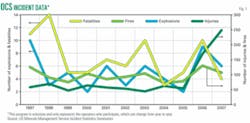Safety statistics contradict the general public’s stereotyped image of oil and gas drilling as being a hazardous business, report spokesmen from the American Association of Drilling Engineers and the International Association of Drilling Contractors.
Statistics demonstrate that industry has made great strides since the 1990s in managing risks. Industry continues working to change negative perceptions about itself, said John Lindsay, IADC chairman and Helmerich & Payne International Drilling Co. executive vice-president for US and international operations, at a safety conference (OGJ, Feb. 11, 2006, p. 33).
AADE national pres., Joe Leimkuhler said he shudders at the “Hollywood image” of the oil and gas industry. Leimkuhler is Shell Exploration & Production Co.’s offshore well delivery manager for TLP & platform operations in the Americas.
Both Lindsay and Leimkuhler acknowledge questions exist regarding the comprehensiveness and accuracy of exploration and production safety statistics, many of which are reported on a voluntary basis.
US Occupational Safety and Health Administration statistics from 2006 show exploration and production has a total recordable incidence rate (TRIR) of 2 compared with 5.1 for construction and 6 for manufacturing. TRIR reflects the number of incidents per a workforce of 100 people during 1 year.
Basically, OSHA defines an incident as recordable if there is a fracture, prescription medication is prescribed, or stitches are required or if the person is unable to return to work.
IADC administers an accident statistics program (ASP) in which members voluntarily submit monthly statistics.
Citing 2007 IADC statistics for rig operations, Leimkuhler said the US onshore TRIR is 5.1, US offshore TRIR is 1.4, and the worldwide rig TRIR average is 2.1.
“To really put safety in perspective, the average 2.1 TRIR for rig operations is lower than [OSHA’s] 3.3 TRIR for real estate,” Leimkuhler said. You are safer statistically on the rig floor than driving around with a real estate agent. That does not mean there are fewer risks on the rig floor, just that we as an industry manage them well.”
Despite that record, there are areas for improvement. “One of the things we do not have for offshore operations is calibrated incident data for TRIR. We can’t get that measure for offshore,” Leimkuhler said.
While the US Minerals Management Service tracks the total offshore injury count and other incident rate information, it is submitted on a voluntary basis from operators. Those data show significant improvement during 1998-2004 as the TRIR went from 3.84 to 0.66 for those companies reporting data. During 2004 to 2007, the TRIR has been relatively stable at 0.66 to 0.86 for the same data set.
But Leimkuhler cautions industry against taking too much comfort in those numbers. The MMS data for number of incidents tell a different story for the total range of offshore operations (See figure).
Based upon MMS statistics, Leimkuhler plotted total number of recordable incidents vs. wells spudded per year in the Gulf of Mexico. The number of spudded wells is a relative measure of total drilling and completion activity (total wells spudded by the operators who report incident rate data represented 60% of the wells spudded each year).
“The high-water mark for the last 10 years is 2000 with 1,382 wells drilled. It has dropped every year since then,” Leimkuhler said. “If you take the wells drilled so far in 2008 and project them out to year end, we’re on pace to drill 576 new wells in the gulf. That’s 42% of the wells drilled in 2000…but the actual number of injuries and fatalities seems to be going up, certainly not down.”
Based on this analysis, Leimkuler questions whether there has been any progress in overall offshore drilling safety since 2002.
“If you look at MMS data for reported incident data from operators who willfully report, you might be inclined to believe that it’s better,” Leimkuhler said. “You can be lulled into sleep by looking at recordable incident rates from a limited data set.”
He doubts that there has been much of a slippage in safety from the operators who voluntarily report their incident rates. In Leimkuhler’s opinion, these organizations are likely to have mature, experienced health, safety, and environment organizations. This is reflected in their performance and reporting culture.
“For the [Gulf of Mexico], Shell actually had our best year of safety statistics in 2007,” Leimkuhler said. “Our drilling activity level was pretty consistent, maybe even up a little from 2006, and it’s certainly up in 2008. The challenge for us as an industry is to celebrate and acknowledge our success in HSE but at the same time maintain ‘a healthy uneasiness.’ The risks are always there; it is the nature of the forces and pressure we deal with in well operations. We do an excellent job of managing those risks, but we cannot afford to ever become complacent or satisfied.”
IADC statistics
The IADC ASP’s 5-year summary report for lost-time incidents (LTI)shows a rate of 0.28 for US water compared with 0.50 for 2002. US land LTI was 1.23 in 2007 compared with 1.73 in 2002. Incidents are calculated per 200,000 man-hr, which is the method used by OSHA.
IADC said worldwide industry totals showed a 2007 LTI of 0.53 compared with 0.65 for 2002.
Joe Hurt, IADC regional vice-president of North American Land, acknowledges that risks exist in drilling operations but says those risks are being managed and removed.
Hurt estimates that drilling contractors representing 95% of offshore drilling rigs report their incidents to IADC, and he believes they are doing their best to report accurately. He estimates land contractors representing 66% of the operating land rigs participate in the program.
